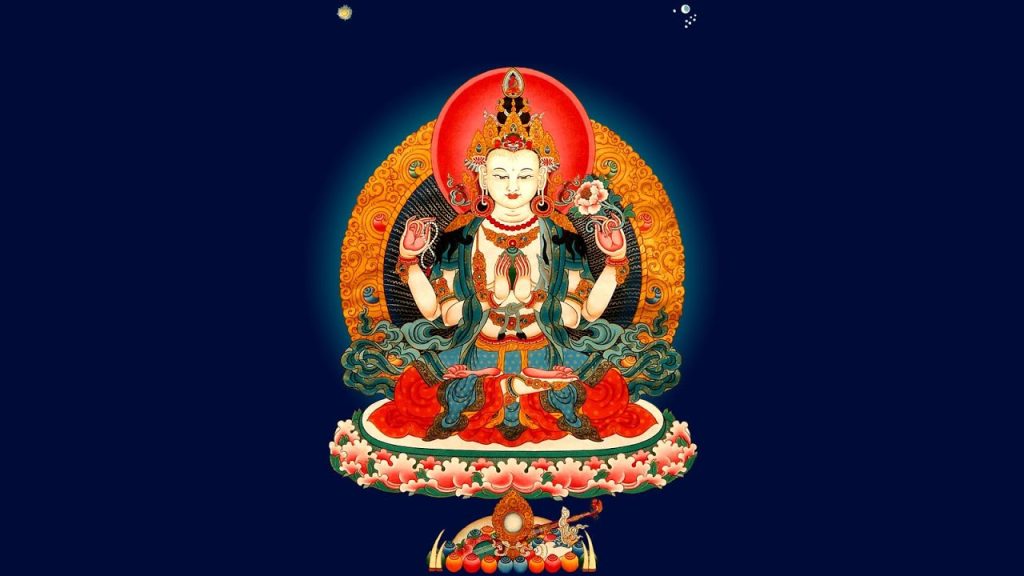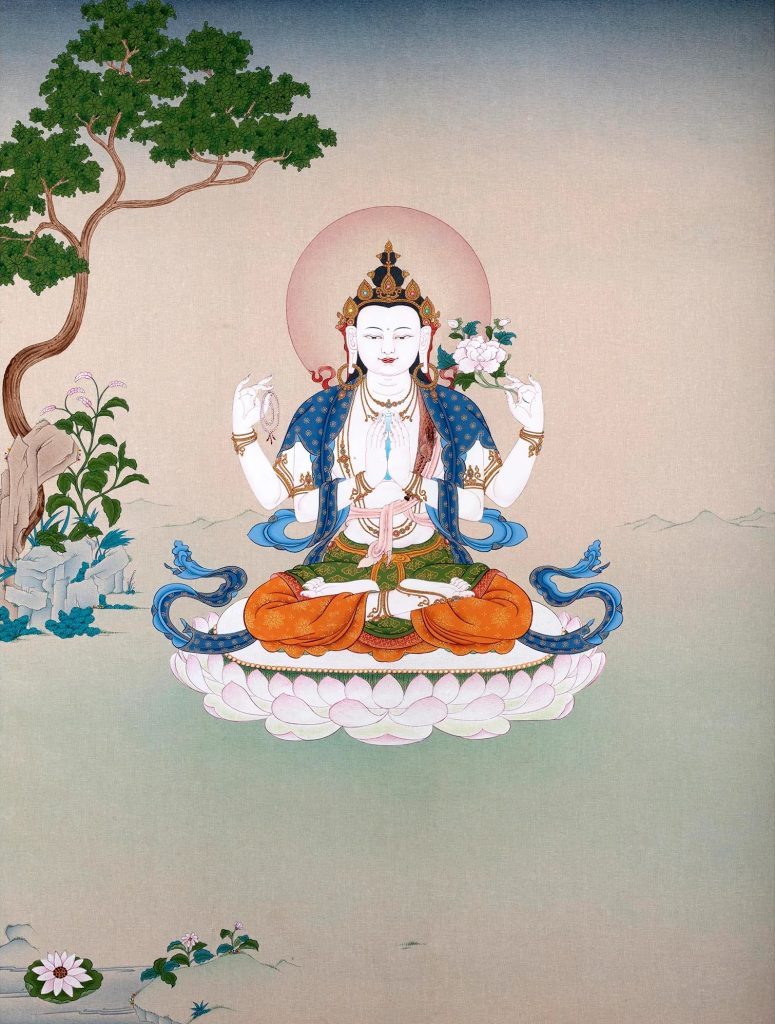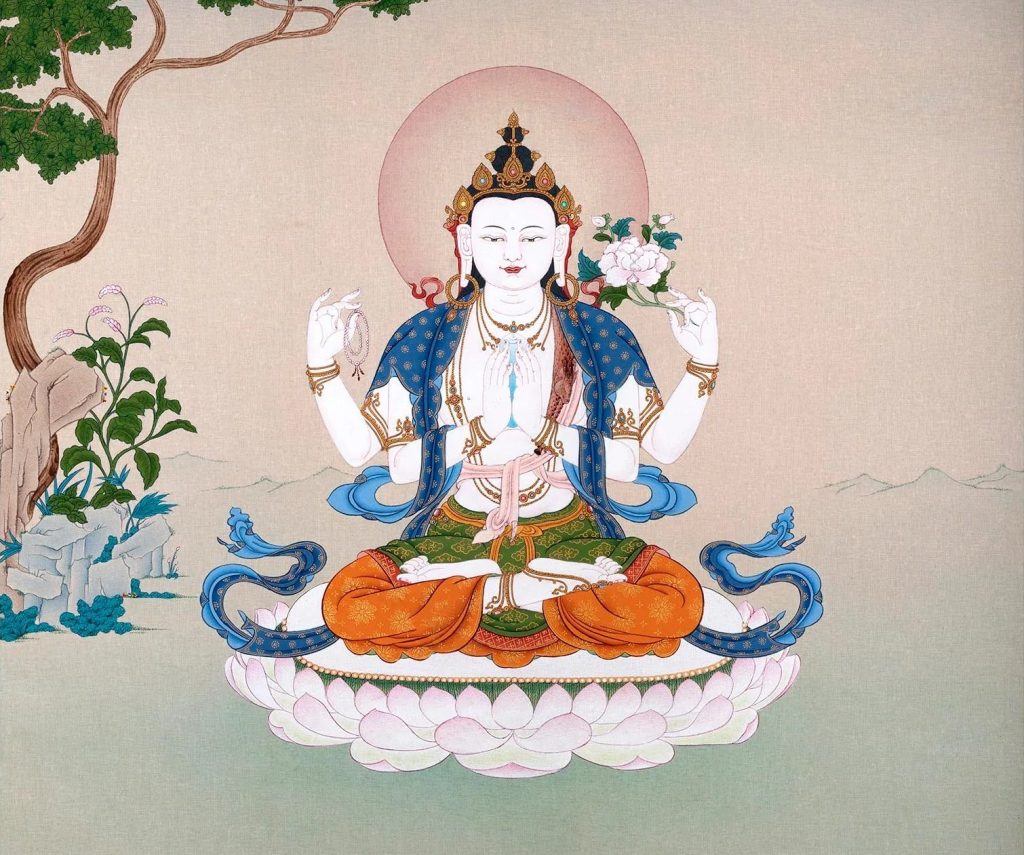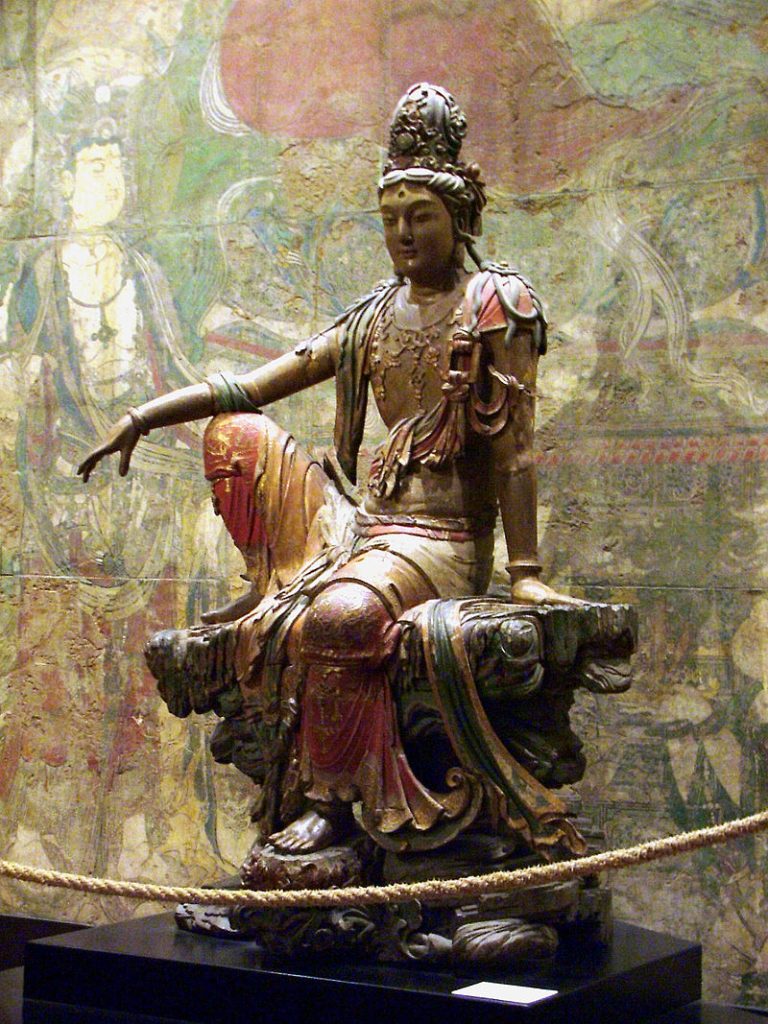Tuesday
Meeting Chenrezig in Sound: Understanding Chenrezig’s Name and the Meaning of the Chenrezig Mantra
by Frederick Meyer
An excerpt from the Shambhala Online Blog posted April 12, 2024
In recent years, Chenrezig—the Tibetan name for the Buddhist deity Avalokiteshvara, the Bodhisattva of compassion—has become an important part of my spiritual practice. I have a strong affinity for sound, and much of my learning about Chenrezig has been in the form of sound and meaning: what “Chenrezig” itself means and how it relates to Avalokiteshvara’s other names, what the Sanskrit and Tibetan versions of the word compassion actually mean, and the meaning of the famous Chenrezig mantra OM MANI PADME HUM.
In this article, I want to share both what I’ve learned about Chenrezig himself, as well as my own process of exploration. I feel the process I’ve followed shows how association and meaning can unfold along the Buddhist path, especially the parts of the path that are rich in energy and iconography.
Throughout this article, I’ll be describing what I learned about Chenrezig in my explorations , as well as weaving in Chögyam Trungpa Rinpoche’s teachings on the same topic. I only discovered Trungpa Rinpoche’s teachings on Chenrezig within the past month, so it’s been very interesting to compare my own independent learning with his teaching, and I hope to illustrate that dynamic as well.
Chenrezig: First Connections
I had heard of Chenrezig growing up, but I didn’t connect strongly to Chenrezig until around three years ago, when my father, a longtime Buddhist practitioner, began practicing Four-Armed Chenrezig sadhana practice with a Tibetan Lama living in Hawaii. At his suggestion, I began joining for the weekly sadhana practice.
The lama often played a YouTube video (with the sound off) during the visualization part of the sadhana. The video includes a thangka of Chenrezig that I really like—something about the eyes and facial expression, and the vibrant colors. I found that looking at it gave me a certain feeling, and I began to carry that with me.

Because of his enthusiasm for the practice, I gifted my father a Chenrezig thangka for one of his birthdays, and then later bought one for myself. When my thangka arrived (about a year and a half ago now), I found that the energy of my own interest in and connection with Chenrezig heightened significantly.

From there, I began exploring Chenrezig in earnest, and that’s where I began to learn in depth about Chenrezig’s name, the meaning of compassion, and the meaning of the Chenrezig mantra.
Chenrezig: What the Name Means
The Tibetan name Chenrezig means “continuously looking,” and has been translated as:
- “One who looks with unwavering eye”
- “Unblinking Eyes”
- “One who always looks upon all beings (with the eye of compassion)”
Trungpa Rinpoche translates Chenrezig as: “He Who Sees All Sentient Beings.”
Chenrezig is the Tibetan version of the Sanskrit name Avalokiteshvara, which means “lord who gazes upon the world.” The idea of this name (in both Sanskrit and Tibetan) is that the loving gaze of compassion—the gaze of Chenrezig, compassion itself—forever holds all beings.
Avalokitasvara: The Female Compassion Deity
What I find most interesting about Chenrezig’s name is that there is another form of the Sanskrit name Avalokiteshvara. Wikipedia does a wonderful job summarizing the history, and it felt like a major revelation to me when I read it. The other name is Avalokitasvara: “Who hears the cries of the world.”
Western scholars originally thought this name had been made up, in error, by Chinese translators from Sanskrit, who named the deity Guanshiyin, “[The One Who] Perceives the Sounds of the World,” or “who perceives the world’s lamentations.” Shortened to Guanyin (and later rendered in Japan as Konan), this is the contemporary Chinese name for Avalokiteshvara, who is represented as a female compassion deity.
Scholars later realized that Avalokitasvara is actually a correct—and older—name of the deity, which was later developed into Avalokiteshvara (adding the sense of “lord” and changing “hear” to “see”). Guanshiyin, “Who Hears the Cries of the World,” wasn’t a mistranslation at all.
As I mentioned, I have a strong affinity for sound, and learning this alternate name of Chenrezig had a profound effect on me. One who gazes (lovingly) upon the world sounds, to me, nice but a little distant—but “hearing the world’s cries” carries a strong feeling I can immediately connect with.
In fact, many of my most immediate and piercing experiences of compassion have been sound-based. As an example, I have a small dog, and this morning when I picked her up, she yelped loudly (I don’t know why, and she wasn’t hurt). I was immediately pierced by a feeling that was so immediate I didn’t have a name for it. I feel it was a strong hit of compassion—the powerful, immediate, primordial feeling that is true compassion, not the refined notion of charity and concern for others that we might often think of.
To continue reading Meeting Chenrezig in Sound: Understanding Chenrezig’s Name and the Meaning of the Chenrezig Mantra by Frederick Meyer please visit the Shambhala Online Blog webpage here.
Entries filed under Community Articles
Shambhala Day Aspiration at Ise, Japan – HIGHLIGHT
As I walked up the large stone steps approaching Amaterasu’s main shrine, I wished that every Shambhalian could experience this place. Mindlessly, I flashed a picture with my camera – before a guard sharply waved his hands as to say, “No pictures!” I quickly apologized and ... continuePosted March 6, 2009 by
Journey to the Kagyu Monlam – HIGHLIGHT
By Corey Kohn Bodhgaya is a dusty little one-horse town, replete with limbless beggars and tattered-looking street children, just as we had been told. And in the middle of this unlikely place is the Mahabodhi temple, commemorating the site where the Buddha attained enlightenment 2,500 years ago. ... continuePosted March 3, 2009 by
Acharya Simon Luna and the Santiago Gong – HIGHLIGHT
This article was a collaborative effort of Magali Meneses, Clarke Warren, Veronica Guzman, Marvin Ross and Marc Matheson. The late Acharya Simon Luna, who passed away in 2007, had a connection to Naropa University and to the Shambhala community of Latin America. Clarke Warren, a Naropa ... continuePosted March 2, 2009 by
Essays on the Shambhala Buddhist Chants
[caption id=”attachment_504″ align=”alignright” width=”150″ This document has drawn immensely appreciative feedback. The following excerpt from the Preface might help explain why: The Kootenay Shambhala Centre is in the town of Nelson, B.C., Canada. We have had the usual disagreements about whether it is appropriate to do ... continuePosted February 27, 2009 by James Northcote
Shambhalacalli en Tepotzlan
Escrito para The Dot. Traducido al español por Luz Rodríguez. Brus y Jean Westby viven la mayor parte del año en Bucerías (México), y la acharya Allyn Lyon les invitó hace poco a formar parte del equipo de un retiro de una semana en Shambhalacalli, en Tepotzlán, ... continuePosted February 25, 2009 by Brus Westby
All and Everything
Thirty-five years ago at the age of twenty-five, I attended the 16th Gyalwa Karmapa’s Black Hat [or Vajra Crown] ceremony in San Francisco at the invitation of a dear friend. This same friend also gave me a copy of Cutting Through Spiritual Materialism, which I still ... continuePosted February 20, 2009 by Larry Barnett
The Ngondro of Babyhood
I conceived my son when I was deep into my ngondro practice. Although my aspiration to receive Rigden abhisheka in the coming months was derailed, I felt that I had received the ultimate blessing. The ngondro for this abhisheka began after the transmission – through the ... continuePosted February 20, 2009 by Rebekka_Henriksen
Great Eastern Sun Rises on the Cape of Good Hope
In 2004, I returned to my hometown in South Africa after 30 years away. I found a sparse and scattered dharma scene. In Cape Town, the only Tibetan Buddhist center was that of Rob Nairn, Akong Rinpoche’s senior South African student. A few months after I arrived, ... continuePosted February 20, 2009 by Jennifer_Woodhull
Streetspace Gallery in Berkeley, California
Two years ago the Berkeley Shambhala Center (BSC) opened the doors of Streetspace, a store-front, multi-purpose space located in downtown Berkeley, California. BSC has occupied the same second-floor space in a dzong-like building for over thirty years, while remaining virtually invisible to pedestrians and traffic. By ... continuePosted February 18, 2009 by
Shambhala in Neverland
For the past four years I have resided part time in mainland China, living in the concrete and tin roof barracks of the artist’s villages that ring the northeast section of Beijing, by the Fifth Ring Road near the airport. Personal voice and uncensored expression are ... continuePosted February 15, 2009 by Ellen Pearlman
Sangha Co-housing opportunity in Northern California
Written by Joel and Sarah Mandel Sarah and I are long-term Shambhala Buddhist practitioners. As we approach retirement age, we’ve been thinking about how, where and with whom we would like to spend the rest of our lives. I’ll bet many of us are considering the same ... continuePosted February 1, 2009 by Joel Mandel
Meditation in a Utah School
Students are practicing meditation in the unlikeliest of places: a small public school in rural southeastern Utah, USA. Encouraged by a once-a-week meditation group, students have learned to relax, pay attention to their breath and decrease negative emotions. How it Began In 2005, my supervisor at the ... continuePosted January 31, 2009 by tom
Taipei Hosts President Reoch During Asia Tour
Written for the Dot The Taipei Shambhala Meditation Group happily hosted Shambhala President Richard Reoch for three days during his October 2008 tour of Asia. This followed Acharya Arawana Hayashi’s earlier February 2008 visit to Taipei which featured an inspiring program: “Shambhala and the Great Eastern Sun ... continuePosted January 31, 2009 by Yeachin Tsai
![]() RSS feed for the Community Articles category
RSS feed for the Community Articles category
View all posts from authors in Community Articles: Jillian_Johnson





























